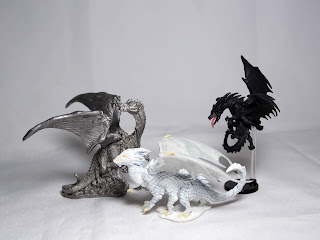I don't believe that it was ever explicitly stated, but I think that everyone understood that this iconic Trampier illustration was of a magic mouth.
I had some left over Kneadatite that I was using to fill some gaps in a minature, so I decided to put it to good use by trying to replicate the magic mouth from the picture.
I'm mostly happy with how it came out, but I'll probably do a bit of sanding to adjust some of the contours around the mouth.
I also need to figure out how I want to model the vaulted arches of the passageway without making things overly complicated.
As far as commercial miniatures go, there are two that I am aware of.
The first is the Citadel Magic Mouth Doorway (Fantasy Specials 2).
I stripped the old paint off of this model a long time ago, but never got around to re-paint it.
The other is the Grenadier Talking Door from the Dungeon Items set (Wizards & Warriors SS04).
This piece is pretty hard to find, but you do see it every now and again.
Sunday, March 29, 2020
Saturday, March 14, 2020
Dracolisks
The original dracolisk from AD&D module S4 The Lost Caverns of Tsojcanth was specifically described as a cross between a black dragon and a basilisk.
I think that it wasn't until 4th edition, that the description of dracolisks expanded to include variants with parentage from other types of chromatic dragons.
I own three different miniatures of the dracolisk.
The old Grenadier Dragonlisk (Dragon Lords 2514) is my favorite, because it looks closest to the Jeff Easley illustration from the module.
The body of the dragonlisk is not very thick, so if you pin the wings when assembling the model, just remember to stagger the pins so that they don't intersect each other when you glue both wings to the body.
The Pathfinder Battles Dracolisk (Dungeons Deep #16) has a nice flying pose, but is rather small, and would probably look better with 15mm miniatures.
It has four pairs of legs instead of the stated three, some of which are posed rather awkwardly.
Last, is the Reaper Dracolisk (Bones 77379), which I painted up as a dracolisk with white dragon parentage.
I cut away part of the base so that both front legs look like they are raised (I saw someone do this for their model, and thought it looked pretty good).
Some shots of the dracolisks all together.
Sunday, March 8, 2020
Zombie Shark
At one time, zombies and sharks stayed comfortably within their own genres.
Then in 1979, Lucio Fulci did the unthinkable, and put zombies and sharks together in the same film.
 |
| Zombi 2 |
 |
| Looks better in comic book form. |
The next evolutionary step in this theme that I became aware of was in Gyo, from the fevered imagination of Junji Ito.
The monsters in this story are created in part by a virus, but are fully dead. The corpses are propelled by bio-mechanical legs that are powered by the gases released from their rotting bodies.
The mechanical nature of the shark from Gyo reminded me of this picture of Bruce from Jaws.
The first full zombie sharks I know of appeared in the Resident Evil franchise.
 |
| Resident Evil 6 |
And most recently in the Zombie Army franchise.
 |
| Zombie Army 4 |
The collector's edition of Zombie Army 4 came out last month, and included a model of a zombie shark.
Based on the dimensions provided, the model seems to be 1/72 scale, but it is more of a Megalodon than a regular shark.
A very similar looking Zombie Shark model is made by Reaper (Bones Black 44112).
The lower jaw is a separate piece, and needed some putty work since there were huge gaps left between the pieces.
I drilled a hole in the shark so I could mount it on a stand, then I painted it up with whites and grays. A thin brown wash was applied to some organs, and a tan wash was applied to parts of the fins.
I prefer the pale dead look to the blood-soaked look because that is what shark corpses that have been floating around in the ocean look like.
Subscribe to:
Comments (Atom)












































